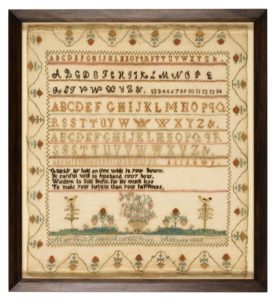Introducing 21st-Century Youth to 18th- and 19th-Century American Art
By Elizabeth Wood, Curator/Educator of the Fielding Collection of Early American Art,
The Huntington Library, Art Collections, and Botanical Gardens, San Marino, CA
The first thing visitors see as they enter the exhibition Becoming America: Highlights from the Jonathan and Karin Fielding Collection is a dramatic presentation of utilitarian tools spanning the years 1770–1870 (Figure 1). The contrast of dark metal on a bright white wall enhances the sculptural qualities of the material and showcases the wide-ranging design and skill of early American artisans. This is a common stop for many of the school tours visiting the Virginia Scott Steele Galleries of American Art at The Huntington Library, Art Collections, and Botanical Gardens in San Marino, CA. Students are often mystified by the shapes and styles of the tools. Surprisingly, the giant ice tongs are among the most quickly recognized objects, a similar pair appearing in the opening scenes of the popular Disney animated film Frozen.
Opening in 2016, the 5,000 square-foot exhibition includes more than 200 objects by 18th- and 19th-century American artisans, including paintings and furniture, as well as ceramics, tools, metalwork, boxes, quilts, and needlework, from New England, New York, and Pennsylvania. Many of the pieces in the collection demonstrate transitional moments in style and design and emphasize the work of craftsmen in rural towns and farms rather than urban centers.
Jonathan and Karin Fielding (Figure 2) presented their collection to the Huntington with the hope that these objects would help to tell the stories of how people lived in early America. As part of the ongoing programming and educational strategies for the collection and the Becoming America exhibition, The Huntington is developing an object-based teaching resource. Targeting students in the 5th, 8th, and 11th grades, the materials align with both national and local curriculum standards and address various content areas including history, visual art, and humanities. Making contemporary connections to objects and primary sources in the collection is an important strategy in the development of these teaching resources.
Bridging the experience gap between life in the 18th century and the 21st century is a challenge, as is navigating the wide-ranging goals that teachers have in presenting the depth and breadth of American history and culture. 5th graders start their studies in the pre-Colonial Era and end with the American Revolution, while 8th graders pick up with the Early Republic and Antebellum Era and progress through the Civil War and Reconstruction. 11th-grade students focus on 20th century issues and move beyond acquiring knowledge to hone their skills in research and historical analysis.
The Becoming America teaching materials work across these time periods to investigate themes, such as identity, cultural exchange, technology, beauty, utility, and natural resources. These topics also present the opportunity to talk about contemporary issues that resonate today, including the ways that immigration and prejudice affects what it means to “become American.” Students use objects from the collections and other primary source materials from The Huntington’s library to explore early American decorative art and consider new ideas and perspectives.
Students make valuable connections through the Fielding Collection. For example, 5th graders study the regional differences of the colonies—a topic that emerges when showcasing variation in the design and craftsmanship of Windsor chairs (Figures 3–4). 8th graders examine the development of a national identity and consider the Industrial Revolution’s effect on the daily life of Americans, aided by the Fielding’s collection of utilitarian objects, such as early lighting (Figure 5). A recent 11th-grade history class studied the schoolgirl samplers on view to discuss the gendering of education and the private and public roles of women in early America (Figure 6).
The curriculum development emphasizes the value of objects as primary sources for inquiry and suggests ways to approach object investigations in the manner of a historian or art historian. In each module, students work with a variety of “object stories” that provide a holistic view of the object in an easy-to-read format. The object’s social and historical context and other key details of its physical features or maker create an opportunity to situate objects in time and place, allowing students to make stronger connections to what they are learning. For example, the portrait of school teacher Albert Gilman (Figure 7) painted by A. Ellis in 1831, provides a window for students to learn more about the sitter’s role as an elected official, the cost of a portrait at the time, and what life was like at his home in Maine. Then, they can conduct further research using newspapers, maps, and other historical events during the lives of the sitter and artist.
Interactive experiences available online will allow students nationwide access to 3D images of the objects to work with them from any distance, providing helpful tools for closer looking. The online object stories will be enlivened with pop-out details, and the chance to ask questions about specific parts of the object, facilitating more effective individual or collaborative student engagement.
The Fielding Collection is a remarkable demonstration of the unique American identity visualized by the history of culture and design. Young people can begin to make sense of the country’s past by exploring the “life” of objects through informative and visual narratives. They are able to connect to history through first-hand interaction with the decorative arts and develop creative and insightful responses about meaning and interpretation. As a result, the Fielding Collection and Becoming America offer students and teachers a dynamic understanding of past and present—one that is not “frozen” in time, but very much part of our everyday lives today.







